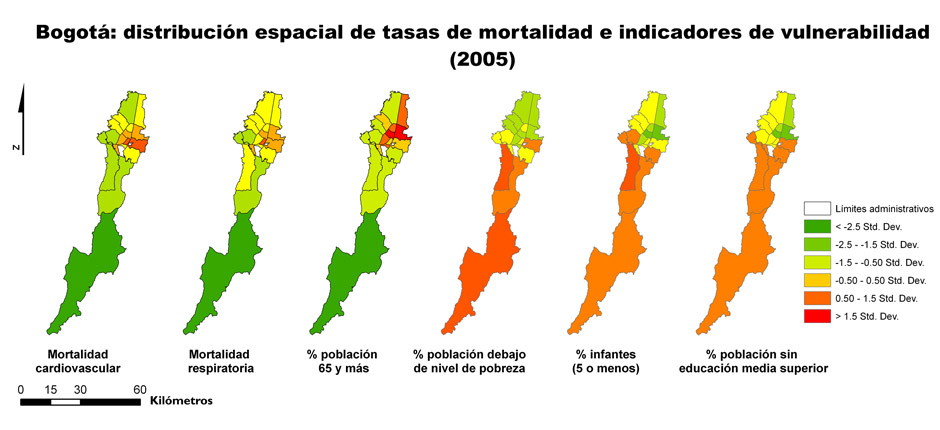SAEMC: South American emissions, megacities and climate (CRN 2017)

1 The large urban centers in South and Central America keep growing posing serious environmental and health problems
2 Traffic emissions are substantial contributors to the burden of pollutants in all megacities. SAEMC has developed and compiled consistent emission inventories that provide the basis for air quality assessments and chemical weather forecasting at various scales
3 C-CATT-BRAMS running in operational mode is able to capture meso-scale events of transport. In this case, a smoke plume advected over Buenos Aires in the fall of 2008 is captured by the model. (photo on the right: http://earthobservatory.nasa.gov/NaturalHazards/Archive/Apr2008/Argentina_AMO_2008107_lrg.jpg)
Project information
Laura Gallarado (laura@dgf.uchile.cl)
Centro de Modelamiento Matemático (UMI), Universidad de Chile
Executive summary
Deteriorating air quality in South American mega-cities is receiving increasing attention from local decision makers, scientists and the public. SAEMC provides regional scale past, present and future climate change scenarios, with emphasis on the evolution of air quality in South American megacities, and on the implementation of coordinated regional chemical weather forecast tools.
Goals
Establish the basis for operational chemical weather forecasting for South American megacities
Provide accurate regional emission and climate change scenarios for South America, with emphasis on the impacts of and on megacities
Strengthen and expand an active research and capacity building network on Earth System Modeling in the Americas
First results
An on-line emission data base has been compiled for Bogotá, Buenos Aires, Lima, Medellín, Santiago, and São Paulo that will be used to develop automated emission scenarios; so far available for Medellín (http://modemed.upb.edu.co/).
Factors affecting local emissions have been compiled which helps environmental authorities manage air pollution. Urbanization maps for the main Brazilian cities have been constructed from satellite images. Inventories for traffic emissions and aerosols including black carbon particles are being developed for Buenos Aires, São Paulo, and Bogotá.
The Chilean Weather Office is now providing chemical weather forecasting for Santiago based on SAEMC work.(http://www.meteochile.cl/modeloPOLYPHEMUSozono.html)
A fully linked climate modeling system is now operational for South America, providing a
sound basis for the comparison of emissions.
A grid-based computational system is being tested.
Project investigators
Laura Gallarado – laura@dgf.uchile.cl
Centro de Modelamiento Matemático (UMI), Universidad de Chile
Co-investigators
K. Longo, S. Freitas, L. Flavio, E. S. Almeida, J. Hoelzemann (CPTEC, Brazil), M. Rojas, L. Gallardo (DGF,Chile),M.Andrade,J.Martins,L.Doprichinski,P.Vasconcellos (USP,Brazil),R.Alcafuz (DMC, Chile), MV Toro (PUB, Colombia), M. Osses (DIMEC, Chile), L. Dawidowski, D. Gómez, P. Smichowski (CNEA, Argentina), E. Behrentz (UDLA, Colombia), E. Concepción (SENAMHI, Peru), R. Delgado, C. Baeza, A. Osses (CMM, Chile), G.Torres (UCO, Argentina), G. Pétron (NOAA, USA), G. García (USACH, Chile), M. Mena (UNAB, Chile), H. Elbern (UKOLN, Germany), A. Córdova (UV, Chile)
Links to other IAI projects
Research in this project is complemented by the Human Dimensions component 2017-HD ADAPTE
Students
Angel Vara, Master, SENAMHI, Peru.
Angélica Rosas Huerta, PHD, UNAM, Mexico.
Arié Araya, Other, Universidad de Chile, Chile.
Ariela D`Angiola, PHD, CNEA, Argentina.
Carlos Castilho , Master, Universidad de Chile, Chile.
Carlos Ross , Master, Chile,
Cinthia Arellano, Master, SENAMHI, Peru.
Claudia Revilla , Master, SENAMHI, Peru.
Carine G. Ramos , Master, Universidad de Los Andes, Colombia.
David Carrasco, Master, Universidad de Chile, Chile.
David Zacarias de Souza, PHD, Universidade de São Paulo, Brazil.
Diana Mielnicki, Master, CNEA, Argentina.
Fabián Fujiwara, PHD, CNEA, Argentina.
Gabriel Nomow Munchow, Master, INPE, Brazil.
Gabriel Preggioni, Other, CNEA, Argentina.
Isabel Ramos, Master, Universidad de Chile, Chile.
Jose Chávez, Master, SENAMHI, Peru.
Karina Malla, Other, Universidad de Chile, Chile.
Karla Caneo, Master, Universidad de Chile, Chile.
Katia Halter do Nascimento, PHD, Universidade de São Paulo, Brazil.
Leila Doprichinski Martins, PHD, Universidade de São Paulo, Brazil.
Madeleine Sanchez, Master, INPE, Brazil.
Magdalena Fandiño, Master, Universidad de Los Andes, Colombia.
Marcelo Alonso, PHD, INPE, Brazil.
Marcelo Tapia, Other, Universidad de Chile, Chile.
Marcio Gledson L Oliveira, PHD, INPE, Brazil.
Marina dos Santos, PHD, CNEA, Argentina.
Mario Gavidia, Master, SENAMHI, Peru.
Mauricio Gaitán, Master, Universidad de Los Andes, Colombia.
Michel Nikolic, Other, Universidad de Chile, Chile.
Natalia Muñoz, Master, Universidad de Los Andes, Colombia.
Orlando Venegas, Master, Universidad de Chile, Chile.
Pablo Saide, Master, Universidad de Chile, Chile.
Paula Rodriguez, Master, Universidad de Los Andes, Colombia.
Pilar Henriquez, Other, Universidad de Chile, Chile.
Robinson Rodriguez, PHD, Universidad de Los Andes, Colombia.
Rodrigo Arroyo, Master, Universidad de Chile, Chile.
Rosana Abrutky, Master, CNEA, Argentina.
Rosario Julieta A. Altamirano, Master, INPE, Brazil.
Sebastian Tolvett, Master, Universidad de Chile, Chile.
Tania Faundez, Other, Chile.

